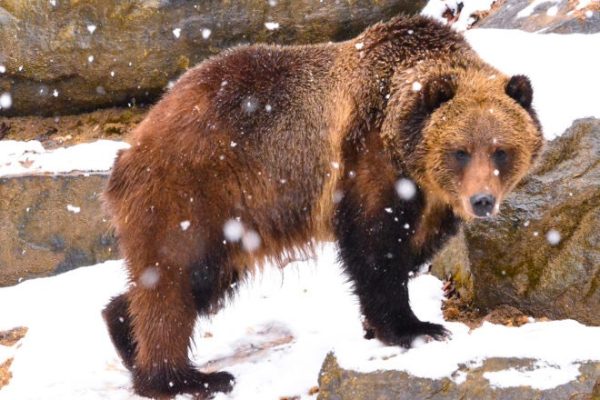
 Growing up, we heard stories of a mother bear and her cub hibernating within their caves during the winter months, then rising as spring came to greet the foliage and nourishment. Indeed, hibernation is similar to a “long sleep” but presents a different and very significant process for animals.
Growing up, we heard stories of a mother bear and her cub hibernating within their caves during the winter months, then rising as spring came to greet the foliage and nourishment. Indeed, hibernation is similar to a “long sleep” but presents a different and very significant process for animals.
During hibernation, breathing becomes shallower, heart rate slows, and body temperature drops, similar to sleep. Other animals, like hummingbirds, experience torpor, a more temporary and less intense form of dormancy than hibernation.
The reason for animals’ dormancy is simple: to conserve resources when food is scarce. Unfortunately, further scientific research into the direct causes and associations of hibernation on a molecular level is limited. Still, the scientific standard often explains that hibernation is prompted by recognition of the photoperiod.
Familiarly, animals and plants possess a “Circadian Rhythm” that recognizes time-based light and darkness patterns. This rhythm prompts the release of neurotransmitters that regulate bodily processes, like melatonin, as the sun sets to prompt rest. This is akin to the animalistic recognition of photoperiod, in which hibernating animals sense the shortening of days and prepare for hibernation.
A bear is one of these animals that recognizes the photoperiod and as they begin the hibernation process. The first step is called hyperphagia, during which they consume as many nutrients as possible. They also travel through a much wider space than usual in search of food, like nuts, berries, and fish.
Surprisingly, the bumblebee is another creature that hibernates. At the end of summer, the entire colony will die, except for the queen, who will hibernate through the cold season. Like the bear, she will consume mass amounts of nectar and pollen to enlarge her fat stores. Also, in preparation for the next colony, she will also mate before summer ends.
In the cold months, both organisms live off of their fat reserves, which produce water and calories for sustenance. Bears also possess a unique adaptation to reduce muscle degradation. Most animals, including humans, lose muscle mass if they remain still for too long, but bears recycle nitrogen as a product of muscle breakdown and use it to build proteins. This allows muscle breakdown to facilitate organ tissue production and the continuance of old muscle.
During this, the queen bumblebee will reside in a hole in the ground or sometimes a cavity in a tree during their dormancy. The bears similarly rest in self-dug dens, caves, or sometimes in hollow trees. Then, when the photoperiod becomes longer and the ice may thaw, the queen will gradually increase her metabolic rate and search for a proper nesting site. After the perfect location is found, she will lay her brood of eggs from the previous autumn’s mating here, establishing her colony for the Summer. Bears also rise gradually and will begin their search for spring food.
These processes, long established through evolution and biological adaptation, are theorized to have historically allowed mammals and birds to survive mass extinctions. Yet, the processes are being threatened with humans driving the sixth mass extinction.
In recent years, bears have been found to awake earlier from their hibernation. This is explained by a global issue of nutrient deficiencies.
Due to deforestation and improper resource management from factory farming, habitats used by hibernating animals are destroyed, and essential nourishment—like a bear’s salmon—is harvested or hunted for human use. This results in hibernating organisms not gaining sufficient fat stores in the autumn to hibernate effectively throughout the winter. Thus, rising early, a bear or possibly a porcupine may begin to search for food in an ecosystem that has not begun producing for the season.
Similarly, deforestation and pesticide use pose a major problem for bumblebee populations by damaging habitats and neurological function. This can, in turn, make it difficult for a queen to mate and maintain eggs throughout the winter. In the spring, this is reflected through bee population losses; since 1947, the U.S. bee population has declined by 60% (The Bee Conservatory).
This is understandably significant with bumblebees, for their pollination of plants increases ecological biodiversity and aids in human crop production again through pollination. With bears, their environmental significance is less apparent in the human realm, yet they are essential to maintaining prey equilibriums and dispersing seeds throughout an ecosystem.
As stated, deforestation is one of the largest concerns for hibernating animals. Between 2001 and 2023, the United States lost 47.9 million hectares of tree cover, equivalent to 479,000 km2 (Global Forest Watch). Again, much of this is caused by improper resource and land use for factory farming, but a large amount is also accounted for by general industry lumber demands.
Indeed, slowing deforestation is a long and grueling fight against corporations and the modern consumerist mindset, yet every individual’s actions can benefit the environment. From buying only used furniture to purchasing animal products from sustainable producers, spreading awareness, and signing legislative bills; it all produces an effect.
You can take action now to further the United States’ environmental focus by pushing for the FOEST Act. It states the following:
“Dear Congressmember…I urge you to co-sponsor and champion the bipartisan FOREST Act to help protect forests and communities and remove illegal deforestation from the products we consume every day” (WWF).
Under the World Wildlife Foundation, environmental advocates worldwide are furthering the environmental movement. By signing this bill, you may do the same and make major contributions to protecting our earth, benefiting hibernating animals and human interests alike.
Want to make an impact? Sign the bill here:
https://protect.worldwildlife.org/page/60771/action/1?_gl=1*f37te6*_ga*MjU2MjczNTc5LjE3MjUzODcyNzU.*_ga_FK6M9RK84Z*MTczMDIxNDY3My41LjEuMTczMDIxNTI0Ni4wLjAuODE4ODQwOTQy.
Also join the Laurel Springs Environmental Club and help save the planet while having fun!